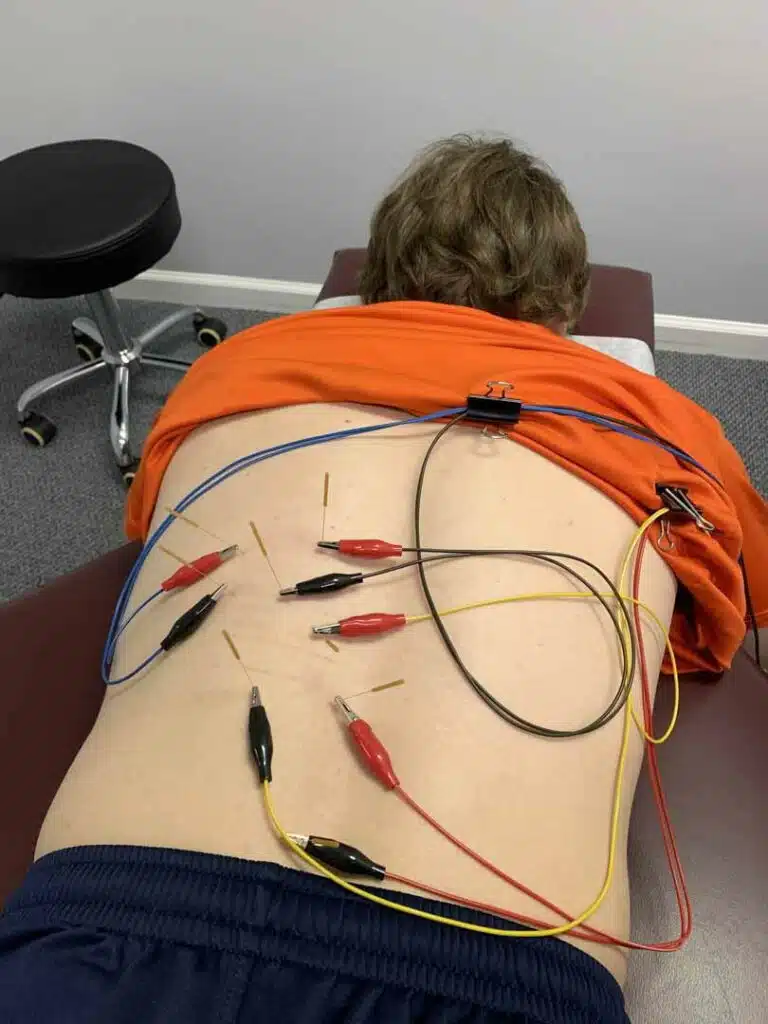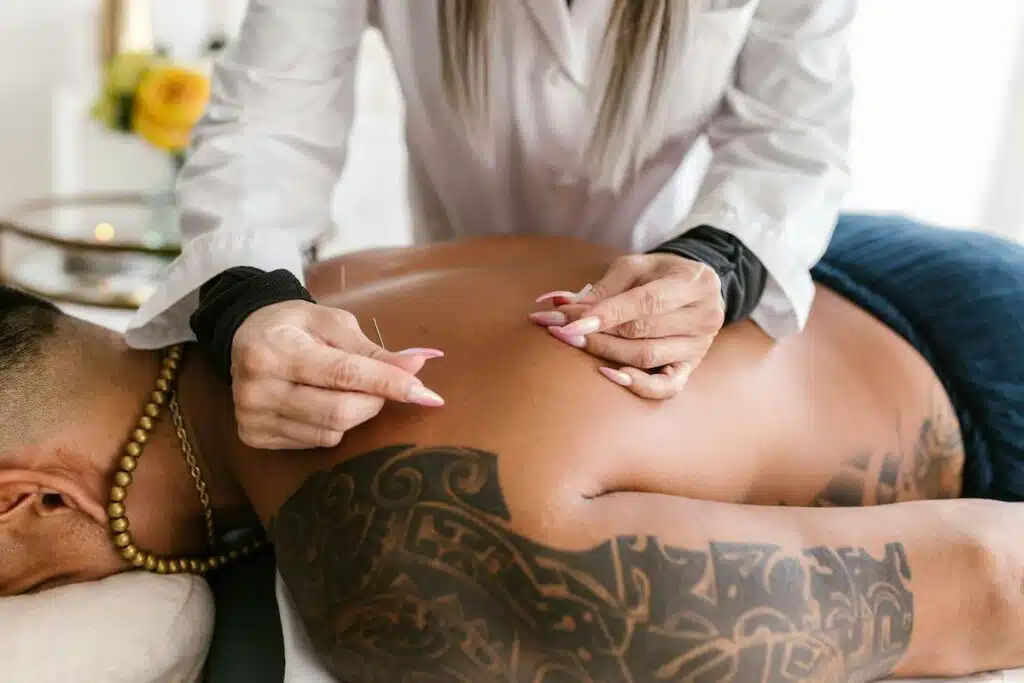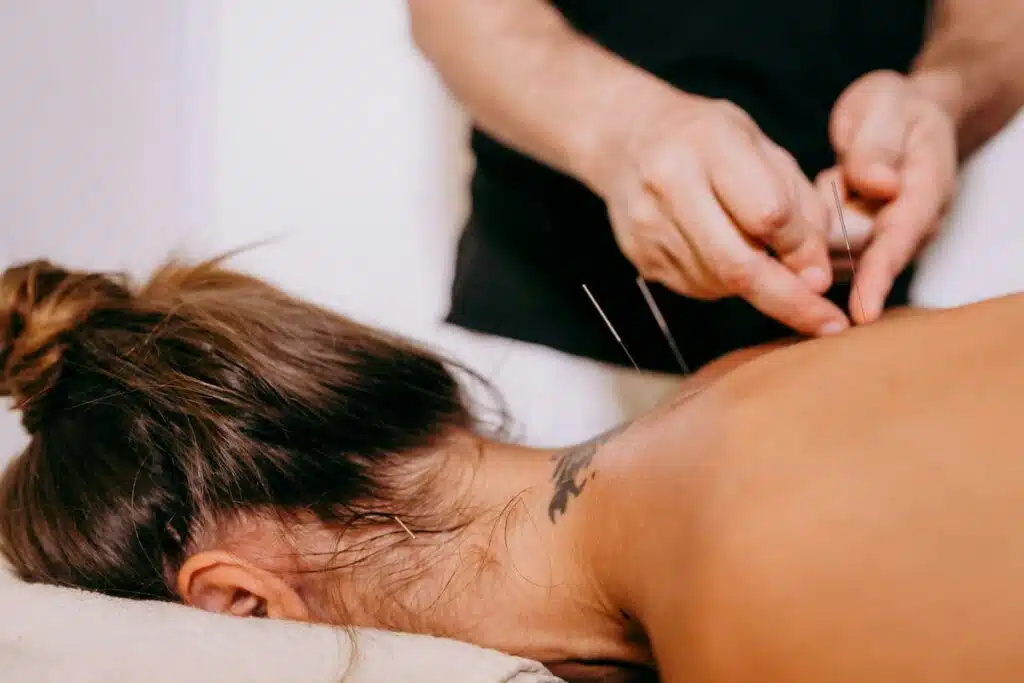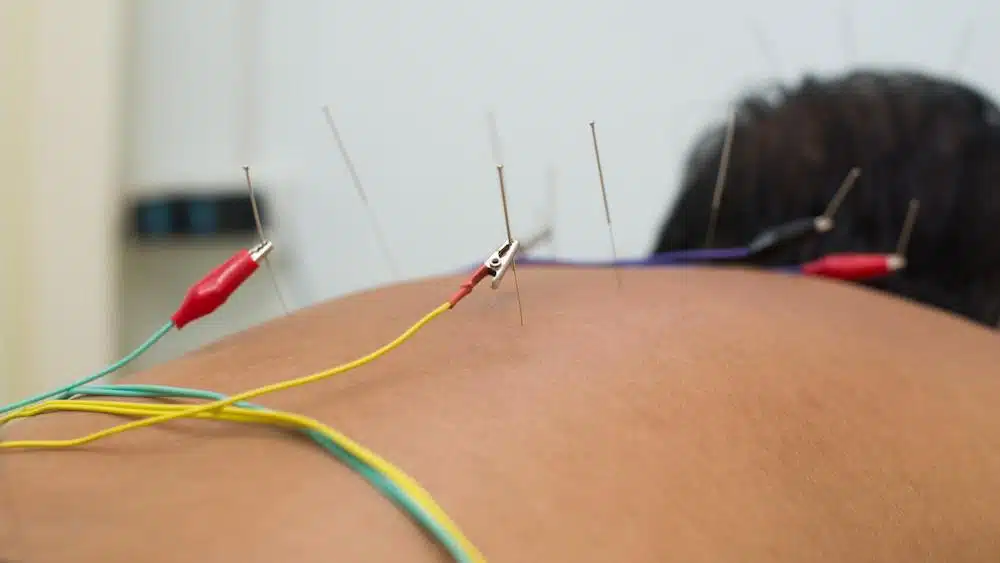Dry needling and acupuncture are popular needle techniques for relieving pain, enhancing healing, and restoring well-being. Although they both involve using thin needles, the philosophies and practices behind the two are very different.
If you seek relief from pain or stress, learn the differences between dry needling vs. acupuncture and which to choose. The article explains how each works to help you make informed decisions about what’s best for your health and well-being.

Dry needling is a modern therapeutic method adopted mainly by Western medicine to relieve musculoskeletal pain. The term “dry” differentiates the practice from “wet needling,” where anesthetics are injected to treat pain. In dry needling, a healthcare professional introduces fine and sterile needles directly into the muscle tissue. These needles target “trigger points,” tight muscle bands that cause pain and discomfort.
Although dry needling came into practice only a few decades ago, it had its roots in the middle of the 20th century as the West caught up with the trigger point theory of pain production. Its development was based on an unexpected discovery of early research into anesthetics for trigger points. During the study, the subjects in the placebo group who received no anesthetic but simply had a needle inserted into their trigger points experienced significant pain relief.
Dry needling is a noninvasive treatment that can relieve pain and stiffness and improve flexibility and range of motion in patients with these conditions.

Acupuncture is based on the principles of traditional Chinese medicine (TCM). Thin needles inserted into acupoints all over the body bring balance to the energy flow or “qi” (pronounced “chee”). According to TCM, this energy flows through pathways called meridians, and when that energy is disrupted, it may cause illness or pain.
The practice of acupuncture dates back to over 2,000 years. As it was passed down over the centuries, it was honed into an organized system of diagnosis and treatment and a standard medical practice in China and the rest of the world. In fact, more than 10 million acupuncture treatments happen every year in the United States alone.
Like dry needling, acupuncture relieves muscle pain and inflammation by releasing trigger points. Moreover, it induces a sense of relaxation and well-being in patients.
Acupuncture helps treat numerous conditions.

The main difference between dry needling vs. acupuncture is the philosophies underpinning these modalities. Dry needling has its roots in Western medicine, dealing with the physical body, particularly muscles and trigger points. On the other hand, acupuncture is founded on the principles of TCM. It aims to balance the body’s energy to reestablish harmony in physical, emotional, and spiritual health.
Even though both practices involve the use of needles, their techniques differ significantly. Dry needling involves the insertion of the needle directly into the trigger point in the muscle tissue, which often reaches deep into the tissues and muscles to relieve tension and pain. Acupuncture places needles at key points (meridians) along the pathway to a specific organ. This means needles may be inserted in places other than the origin of pain.
Dry needling is primarily used to treat musculoskeletal dysfunctions and in conjunction with other therapies, such as physical therapy. The results are usually immediate; many patients experience relief after a session.
In contrast, acupuncture treats the unbalanced energy system of the human body, reaping benefits in various organ systems. While acupuncture patients feel relaxed right after a session, pain relief is more gradual, often requiring multiple sessions to achieve.

Before a dry needling session, your provider will review your medical history and perform a physical exam to determine if the treatment is right for you.
During the session, your provider will feel for the trigger points and insert sterile, disposable needles either just below the skin or deep into the muscle. The needles may stay in place for a few seconds up to 20 minutes. Twitching is a normal response to the needle insertion. Afterward, you may experience soreness and slight bruising; staying active and hydrated is encouraged for recovery.
During an acupuncture session, your acupuncturist will first discuss your concerns, review your medical history, and assess your wellness by examining your tongue and feeling your pulse.
You’ll then lie on a padded table in a relaxing environment. The acupuncturist will insert thin, sterile needles into specific points on your body. You may feel a light pinch, tingling, or pressure. The needles stay in place for at least 20 minutes, during which you may feel deeply relaxed or even fall asleep. Afterward, the needles are removed, and your acupuncturist will suggest a follow-up treatment plan based on your needs.
Dry needling and acupuncture have many differences. Each is unique in its origin, procedure, and philosophy. However, both approaches aim to relieve pain and restore overall health.
The choice between dry needling vs. acupuncture is a matter of personal health goals and preferences. Dry needling may be appropriate if you want to focus on musculoskeletal pains or injuries. If you want a holistic treatment that helps your physical and emotional well-being, then acupuncture is the way to go.
If you seek dry needling for pain management, consult Dr. Eric Stumpff of Stumpff Chiropractic. He is a nationally board-certified and licensed chiropractor in Plantation, FL, who can perform this treatment to provide relief for various musculoskeletal conditions.
Take the first step toward a pain-free life. Schedule your appointment today!
